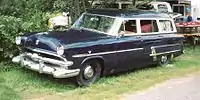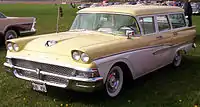Ford Country Sedan
The Ford Country Sedan is a full-size station wagon that was built by Ford in the United States from 1952 until 1974. It was part of the U.S. Ford full-size car line available in each year.
| Ford Country Sedan | |
|---|---|
.jpg.webp) 1956 Ford Country Sedan | |
| Overview | |
| Manufacturer | Ford |
| Model years | 1952 to 1974 |
| Body and chassis | |
| Class | Full-size station wagon |
| Body style | 2-door station wagon 4-door station wagon |
| Related | Ford Ranch Wagon Ford Country Squire |
The Country Sedan was the mid-trim station wagon in the U.S. Ford range. Unlike the Country Squire, the Country Sedan featured plain body sides. As a full-size wagon, it could carry up to 9 passengers, if so equipped.
The Country Sedan was based on the Customline from 1952 to 1954. Beginning in 1955, Ford spun their station wagons into their own series and the Country Sedan continued to represent the mid-trim level station wagon. During the 1960s and 1970s, the Country Sedan was approximate to the Galaxie and later the Galaxie 500 in trim elements. For 1972, 1973 and 1974 the model was marketed as the Galaxie 500 Country Sedan and from 1975 it was rebranded LTD wagon. By this time the trim level was identical to the Country Squire apart from the absence of simulated wood exterior paneling.
 1953 Ford Customline Country Sedan
1953 Ford Customline Country Sedan 1954 Ford Customline Country Sedan
1954 Ford Customline Country Sedan_(5888551130).jpg.webp) 1955 Ford Country Sedan
1955 Ford Country Sedan 1956 Ford 6-Passenger Country Sedan
1956 Ford 6-Passenger Country Sedan 1956 Ford 8-Passenger Country Sedan
1956 Ford 8-Passenger Country Sedan 1957 Ford Country Sedan
1957 Ford Country Sedan 1958 Ford Country Sedan
1958 Ford Country Sedan 1959 Ford Country Sedan
1959 Ford Country Sedan.jpg.webp) 1965 Ford Country Sedan
1965 Ford Country Sedan 1966 Ford Country Sedan
1966 Ford Country Sedan.jpg.webp) 1967 Ford Country Sedan
1967 Ford Country Sedan.jpg.webp) 1968 Ford Country Sedan
1968 Ford Country Sedan.jpg.webp) 1969 Ford Country Sedan (with non-standard wheels)
1969 Ford Country Sedan (with non-standard wheels) 1972 Ford Galaxie 500 Country Sedan
1972 Ford Galaxie 500 Country Sedan.jpg.webp) 1973 Ford Galaxie 500 Country Sedan
1973 Ford Galaxie 500 Country Sedan
Rear gate advances
(Originally from Ford Country Squire)
Prior to 1961, all Ford wagons utilized a two-piece tailgate assembly that required the operator to lift the rear window and lock it into place via a mechanical support, and then drop the tail gate down to fully access the rear compartment.
For the 1961 model year, Ford incorporated a tailgate assembly that featured a self-storing window that could either be rolled down into the gate via crank on the outside of the gate, or by an electrical motor actuated by the key or an interior switch. A safety lockout measure required that the rear window had to be fully retracted into the gate before it could be lowered.
With the introduction of the 1966 models, all Ford wagons introduced the Magic Door Gate which allowed the tailgate on the vehicle to function as a traditional tailgate that could be lowered, or a door that swung outward for easier access to the seating area. The Magic Door Gate was made possible through a use of a traditional stationary hinge on the right, and a combination of hinges along the doors left side, which carried the weight of the gate as it swung outward when used as a door.
General Motors, Chrysler, AMC, and Toyota would adopt a similar configuration by the end of the 1960s.
.jpg.webp) 1966 Ford Country Sedan demonstrating that year's new Magic Doorgate that folds down...
1966 Ford Country Sedan demonstrating that year's new Magic Doorgate that folds down....jpg.webp) ...and swings sideways like a door.
...and swings sideways like a door.
| Wikimedia Commons has media related to Ford Country Sedan. |